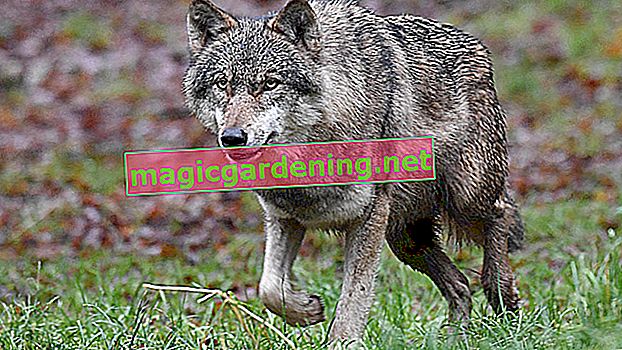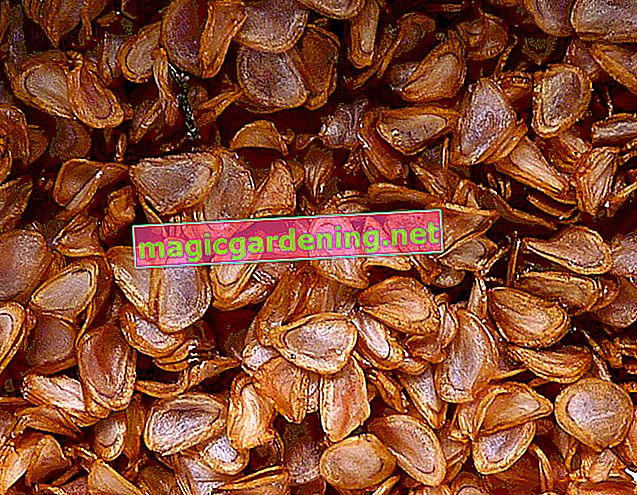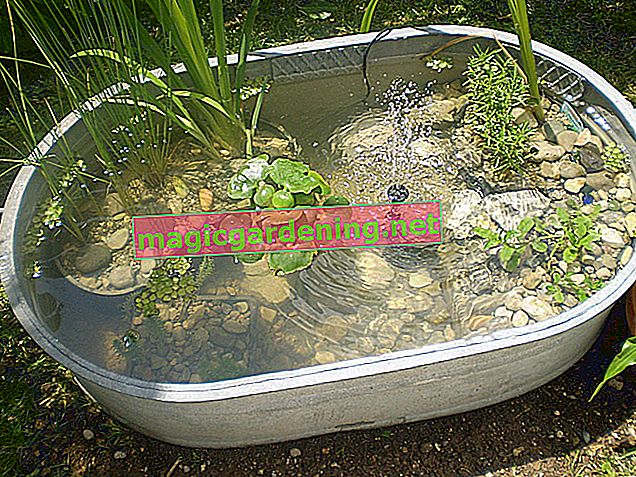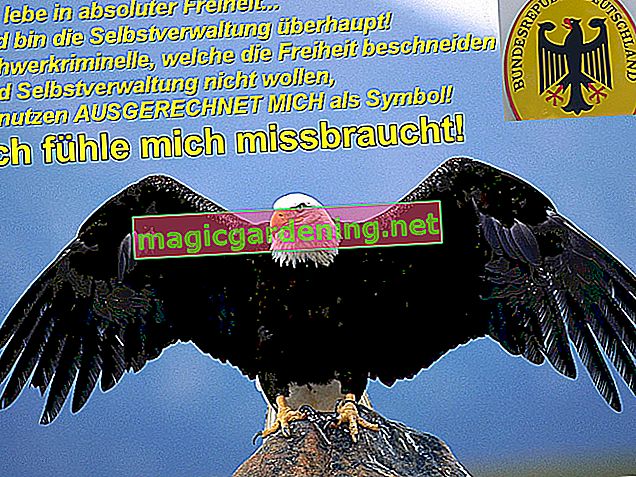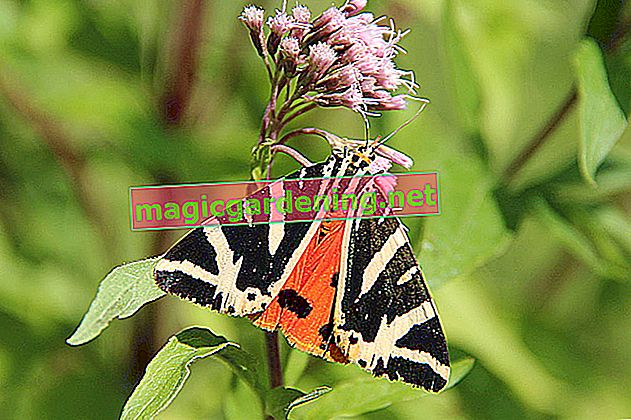
the essentials in brief
- the admiral butterfly belongs to the noble butterfly family
- Originally from southern Europe, it can now be found in Central Europe, Eurasia and North America
- Forage plants rich in nectar such as beard flowers, lavender, thyme or butterfly lilac attract the admiral and other butterflies into the garden
- Since global warming, the admiral butterfly no longer winters south of the Alps but in southwest Germany or east France
Characteristics
- Scientific name: Vanessa atalanta
- Family: Edelfalter (Nymphalidae)
- Wingspan: five to six centimeters
- Appearance: basic color dark brown, conspicuous red bands in the middle, black with white spots on the outside
- Distribution: in large parts of the northern hemisphere, especially Eurasia and North America
- Habitat: Forests, meadows and gardens
- Diet: mainly flower nectar (nectarivor)
- Social behavior: loner
- Daily rhythm: diurnal
- Mating season: in Central Europe between May and June
- Life span: one to two years
- Related species: various subspecies in Europe and North America
Systematics
The diurnal admiral belongs to the noble butterfly family (Nymphalidae), which includes around 200 different species in Germany alone. There are around 6,000 different species worldwide, but many of them are endangered. In Germany, the peacock butterfly, the large and the small fox and the painted lady also belong to this group. Like all butterflies, the admiral usually keeps its wings folded and closed when sitting, which sometimes makes it difficult to identify - especially since the colors of the wings on the top and bottom are very different. Like other noble butterflies, admiral butterflies also have three pairs of legs, but the foremost of which is greatly shortened and lies close to the body. It is primarily used for personal hygiene, but is also used for touching, tasting and smelling.
also read
- Get to know the beautiful clematis better
- Bees, butterflies, hedgehogs & Co. - this is how you create a colorful wild meadow
- Get to know the hornet queen
Digression
Can you confuse the Admiral Butterfly with other species?
Due to its unmistakable color of the wings, the Admiral butterfly cannot be confused with other noble butterflies. However, the variance in coloration is quite large in some places, so that there used to be a whole range of subspecies. Meanwhile, many of them have turned out to be just variations of one and the same species.features
The striking coloring of the admiral ensures that you can easily identify him during a sighting. The most important distinguishing features of the butterfly, which is quite large with a wingspan of up to 6.5 centimeters, can be found in the following table.
| Wing part | coloring | Other features |
|---|---|---|
| Basic colouration fore and hind wings | dark brown | Fore wing tips black with white spots of different sizes |
| Middle fore wing | wide red band | females often have a white dot in the middle of the bandage |
| Rear wing | wide red band on the outer edge | in the middle of the band are black dots arranged in a row |
| Outer edge of fore and hind wings | lined with a fine white line | The line is not continuous, but has small, black dots |
| Fore wing underside | white, black, red and blue patterned | - |
| Hind wing underside | marbled brown to brown-violet | - |
The admiral's caterpillars grow up to four centimeters and can look quite different depending on the region. As a rule, they are yellowish-gray or brown in color, but they can also be significantly darker to black-brown or even black. There are often cream-colored spots of different sizes on the flanks, which are also arranged in a row. However, these spots are not a sure distinguishing feature, as not all caterpillars have them.
Occurrence

In contrast to many other native butterflies, the admiral is not adapted to a special habitat, but occurs in different habitats. The animals can be found in forests and pastures as well as on arable land, in gardens or parks. In addition, admirals occur both in the lowlands and at heights of up to 2000 meters. The admiral originally comes from southern Europe, where he still spends the winter today.
The admiral butterfly is not only found in Central Europe, but also in other parts of Eurasia and North America, with various subspecies to be found here. These usually also migrate.
Digression
When is the best time to watch the admiral butterfly?
In Central Europe the admiral can be observed between May or June and well into October. Even overwintering specimens have rarely been spotted during the autumn or winter months, but these usually die with the first frost. Exceptions are wintering admirals in southwest Germany, which seem to find suitable conditions here.Way of life and reproduction
“The caterpillar says: It's the end. The butterfly says: It is the beginning. " (unknown)

The immigrant admirals can be seen particularly often between May and June, as their mating season falls during this period. The males often wait in elevated places - for example on hills - for females to fly by. Then, unlike other butterfly species such as the small fox or the peacock butterfly, the female lays her light green eggs one by one on nettle shoots. The caterpillar that hatches from it builds a real nest from the leaves and other parts of the plant, in which they roll up for protection. As soon as this dwelling wilts, they build a new one.
The caterpillars eat for a month until they finally pupate. The brownish colored pupa looks quite small compared to the finished butterfly, but it will slip away after another 14 days. The young admiral butterfly is sexually mature only after another 40 days, although in our part of the world only one generation is grown per season. From October the moths move south again, where they spend the winter and also mate and lay eggs there. In some years the caterpillars can occur en masse, but are not dangerous for humans, animals or plants.
This post shows how reproduction works in butterflies and how a small caterpillar becomes a magnificent butterfly:
YoutubeThe Admiral's Migration
The admiral butterfly is one of the so-called migratory butterflies that, like migratory birds, fly south every year from October and return to Central Europe at the end of winter. The next generation that hatches here also embarks on the arduous journey in autumn, after all, this behavior is primarily genetic. By the way, every admiral only makes the arduous hike once in his life: either to the south or to the north, where he then mates and lays his eggs.
Where the moths fly to, however, determine environmental factors such as the climate and the food supply. For this reason, many admirals no longer cross the Alps, but hibernate in southwest Germany or in eastern France. Due to global warming, the animals have also found suitable conditions here for several years.
Admirals can basically fly several thousand kilometers and even cross high mountains, but with an average speed of between seven and 15 kilometers per hour and around ten beats per second, they are comparatively slow - very different from the nocturnal swarmers, which travel up to 50 kilometers per hour are among the fastest butterflies. So it's no wonder that the admiral needs about two weeks to cover the 1000 to 2000 kilometer route between Central Europe and Southern Europe or North Africa.
Digression
How does the admiral find the right way?
How or what migratory butterflies like the admiral orient themselves on their way has not yet been comprehensively researched scientifically. Nevertheless, biologists have made assumptions that were partially confirmed by stimulation. The theory that the moths align themselves with the sun is considered likely. However, it has so far neither been confirmed nor ruled out that butterflies also orient themselves to the earth's magnetic field.Why do butterflies like the admiral migrate at all?
Why the admiral leaves his traditional home regions to spend the summer in Central Europe has not yet been adequately clarified. The animals probably flee their homes in summer to face the drought there and thus a shortage of food. Another possible explanation, however, is that the animals simply expand their area by chance and possibly follow atavistic behaviors. These are genetically shaped migrations, which, however, originate from climatically different times and have not yet adapted evolutionarily. This in turn explains why so many of these butterflies freeze to death in this country because they did not make the return trip in time.
This short video provides impressions of the long journey of the Admiral Falter:
YoutubeWhich native butterflies are still on the move?
In addition to the admiral, other native butterfly species also belong to the migratory butterflies and some of them even cover considerably further distances:
| Butterfly species | Scientific name | Occurrence | distribution | Hike |
|---|---|---|---|---|
| Painted Lady | Vanessa Cardui | Europe, Asia, North Africa, North Africa, Australia | Dry grasslands, steppe areas at altitudes of up to 3000 meters | fly into Europe between May and July, overwinter in southern Europe or North Africa |
| Postillon (large post squirrel) | Colias croceus | North Africa, South Europe, Central Europe, Turkey, West Asia, Mediterranean and Atlantic islands | clover-rich meadows | does not overwinter north of the Alps |
| Skull hawkers | Acherontia atropos | tropical regions of Africa, but also North Africa and the Mediterranean region, the Middle East, Saudi Arabia and West Asian countries, Central Europe to Iceland (the latter only during the summer months!) | preferably dry, sunny regions with a high number of bushes and many nightshades | does not overwinter north of the Alps, probably covers the longest way of the European migratory butterflies |
| Pigeon tail | Macroglossum stellatarum | large parts of North Africa, Europe and Asia | Little specialized in certain areas of life, many nectar-rich forage plants must be available | fly fast - cover 3,000 kilometers in around 14 days |
| Winch swarmers | Agrius convolvuli | very large distribution area from the tropics and subtropics of Asia and Africa to northern Europe | open, sunny and bushy landscapes | fast fliers, reach top speeds of up to 100 kilometers per hour, therefore widespread use, very sensitive to temperature |
nutrition
The caterpillars of the Admiral butterfly feed mainly on nettles in Central Europe, which is why they can be found wherever larger populations can be found. The adult animals, on the other hand, prefer to suckle on typical butterfly food plants such as butterfly lilac, but also sedum plant, water feast or blackberries.
In autumn, the animals recharge their batteries for the upcoming journey with high-energy windfalls, whereby they prefer plums and plums as well as pears. Windfalls are one of the most important sources of food for the butterfly in autumn, as it provides a lot of energy. In addition, the moths like to suckle on various autumn flowers, but mainly on the flowers of the ivy.
How to attract Admiral butterflies to the garden

To attract an admiral butterfly into the garden, all you have to do is plant some popular forage plants in your beds. But even without new plants, the animals can be fed, especially in autumn, for example with so-called “folder filling stations”.
Suitable forage plants for the admiral
Buddleia (Buddleja davidii), also known as butterfly lilac for a reason, is the perfect lure for the admiral and other butterfly species such as white flies, the painted lady, the peacock butterfly and the little fox. But bumblebees and bees also like to fly to the nectar-rich plant. The undemanding plant grows very quickly and is cut back vigorously in autumn or spring. It then drives out again in the spring. You have the choice between numerous different varieties with purple flowers (in different shades), with pink or white flowers.
If you want to offer the admiral a suitable nursery, you should leave nettles in a sunny corner of the garden. In autumn, however, other plants become important that provide the butterflies with energy for their long journey: Therefore, fruit trees (especially plums and pears) and ivy should not be missing in a butterfly-friendly garden. Whole swarms of migratory butterflies can cavort on these plants and are happy to accept the offer.
Which forage plants are still popular with butterflies?
The Federal Agency for Nature Conservation recommends some particularly nectar-rich forage plants to lure butterflies like the admiral - but also other species - into the garden. When choosing the variety, make sure to give preference to the original species, and the flowers should be as simple and unfilled as possible - half-double or double flowers are not suitable as fodder plants, as the animals cannot get the nectar here.
| Plant species | Scientific name | growth | blossom | Location | ground | sorts |
|---|---|---|---|---|---|---|
| Beard flower | Caryopteris | Subshrub | umbel-shaped, purple to purple, between August and September | sunny | dry to sandy, no waterlogging | including 'Blue Fountain', 'Summer Sorbet', 'Heavenly Blue' |
| Blue pillows | Aubrieta | cushion-forming, carpet-forming | various shades of purple or red, white, between April and May | sunny | fresh, well drained | including 'Winterberg', Bressingham Red ',' Hamburger Stadtpark ',' Blue Tit ' |
| Globe thistle | Echinops ritro | clumpy, upright | purple to purple-blue, between August and September | sunny | dry to moist, well drained | including 'Arctic Glow', 'Veitchs Blue', 'Blue Globe', Echinops bannaticus |
| Fine thistle / flat leaf man litter | Eryngium planum | clumpy, upright | blue ball flowers between July and September | sunny | dry, well drained | Type of origin |
| Sedum plant / large fat leaf | Sedum telephium | clumpy, bushy | umbel-shaped between August and September, different colors | sunny | nutritious, dry to fresh | including 'Karfunkelstein', 'Munstead Dark Red', |
| Herbstaster / Raublatt-Aster | Aster novae-angliae | clumpy, upright | Different colored bowl flowers between September and October, choose unfilled varieties | sunny | fresh, nutritious | including 'Rudelsburg', 'Herbstflieder', 'Lachsglut', 'Violetta', 'Abendsonne' |
| Purplish toadflax | Linaria purpurea | clumpy, upright | purple panicle flowers between July and August | sunny | rather poor in nutrients, loamy to sandy | Type of origin |
| lavender | Lavandula angustifolia | clumpy, upright | simple spikes in purple, pink or white between July and September | sunny | dry, rather poor in nutrients | including 'Imperial Gem', 'Arctic Snow', 'Hidcote Pink', 'Munstead', 'Hidcote Blue' |
| High flame flower / phlox | Phlox paniculata | clumpy, upright | different colored umbellate flowers between July and September | sunny to partially shaded | nutritious, fresh to moist | including 'Düsterlohe', 'Kirmesländler', 'Pax', 'Purple Kiss' |
| Spiky splendor notch | Liatris spicata | clumpy, upright | purple or white spikes between July and September | sunny | fresh, well-drained, nutritious | ao 'Kobold', 'Alba' |
| Mountain stone herb | Alyssum montanum | clumpy, prostrate to upright | yellow grape blossoms between April and May | sunny | dry, stony to gravelly | Type of origin |
| thyme | Thymus vulgaris | pillow-forming | purple umbels between July and August | sunny to partially shaded | loamy-sandy, rather poor in nutrients | Type of origin |
Folding petrol stations
But not only the plants mentioned, also so-called “butterfly filling stations” are suitable for the autumn feeding of the admiral. To do this, provide malt beer mixed with a little honey (alternatively, sugar water works as well) in a flat container. A flat saucer, for example, which you can simply place outside in a slightly elevated position, is ideal.
Why should you lure butterflies into the garden at all?
Insects have been declining in number for years, which of course also applies to butterflies. Many of the approximately 3700 species native to Germany are struggling to survive, as they can hardly find food thanks to modern agriculture and sterile gardens. This also applies to the gardeners' willingness to experiment, because instead of nectar-rich native wild plants and bushes, sterile hybrid plants, exotic plants from distant lands and green standard lawns grow in many hobby gardens - if not all the green has already been displaced by stones so that you don't have too much work. The targeted planting of forage crops is therefore an important step in helping endangered insects - such as the fascinating butterflies - and providing them with suitable food sources all year round.
Can you also specifically feed butterflies? What to look out for

Admirals are especially foraging in autumn. You can help the animals by leaving windfalls outside or by specifically feeding the moths with sugar water. Many an exhausted butterfly sitting on the ground could be saved in this way. Here's how to properly feed a butterfly:
- Butterflies can only ingest liquid food because they suck it up through their proboscis
- So prepare sugar water: Heat water and dissolve some sugar in it, the ideal ratio being four parts water to one part sugar.
- Let the mixture cool down.
- Dip a sponge or kitchen towel into it.
- Alternatively, just drip some solution directly in front of the butterfly.
- Wait for the animal to use it on its own.
- Alternatively, some fruit juice or sliced, juicy fruit such as an orange are suitable sources of food.
Make sure that the area around the butterfly and the food source is not too dirty, otherwise the animal could get caught in it and no longer free. It becomes particularly dangerous when the wings stick together.
What species of butterflies can still be seen in gardens?
In Germany there are around 170 different species of butterflies, some of which are quite common - such as the admiral - others are rather rare. The following species can often be seen in our gardens:
- Bluish (Lycaenidae indet) : different species with typically bluish wing coloration that occur in different habitats
- Painted lady (Vanessa cardui) : Migratory butterfly, which is particularly found in regions with many thistles
- Big fox (Nymphalis polychloros) : loves sun and warmth, occurs more often, especially near the forest
- Large cabbage white butterfly (Pieris brassicae) : widespread species that occurs in almost all habitats
- Little fox (Aglais urticae) : very common and widespread species that can often be seen in the garden
- Small cabbage white butterfly (Pieris rapae) : common, less specialized butterfly
- Swallowtail (Papilio machaon) : strikingly large, characteristic yellow and black drawn butterfly
- Peacock butterfly (Aglais io) : also common moth with characteristic eye spots
- Mourning cloak (Vanessa antiopa) : dark brown butterfly with a wide, cream-colored border and pretty drawing
- Brimstone Butterfly (Gonepteryx rhamni) : pretty, bright yellow colored butterflies
frequently asked Questions
Is the admiral butterfly an endangered species?
The admiral is currently not considered to be threatened, but this can change quickly in view of climate change and the associated changes in the cultural landscapes.
What does the admiral butterfly do in winter?
Admirals usually do not overwinter in Central Europe, but fly to warm southern climes in October. They can cover several thousand kilometers. From there they return in the following spring to mate and lay their eggs here. If an admiral misses the winter migration south, he dies with the first frost. Until a few decades ago, admirals still regularly crossed the Alps to spend the winter in the Mediterranean countries or even in North Africa. In the meantime, however, there is a stable population that only flies as far as the Upper Rhine and spends the cold season there.
Why does the Admiral Butterfly have his name?
The admiral owes its name to its striking wing drawing, which is reminiscent of a military uniform.
How long does the admiral butterfly live?
Compared to other butterflies, the admiral is quite old: the butterfly can reach an age between one and two years and does not become sexually mature until around 40 days after hatching.
Does Admiral Butterflin have natural enemies?
The striking butterfly is on the menu of many bird species.
Tips
So that butterflies can hide from their predators, you should set up a so-called butterfly hotel in the garden. This also serves as a shelter for other beneficial insect species. Trees with dense foliage and bushy shrubs, on the other hand, serve the animals as hiding places in wet and cold weather.

